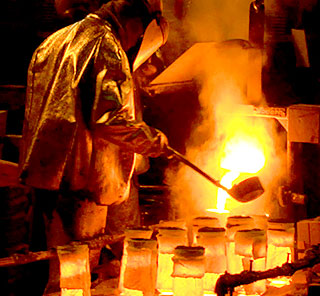Post Weld Heat Treatment for Stainless Steel
Chromium carbides form in stainless steels along either side of a weld. These carbides form where the metal is in the temperature range of approximately 1100 – 1500 F. Since the weld pool is well above this temperature and the base metal is below it, there is always some part of the welded part which was in that temperature range. The quantity of carbides which form depends on several factors, including the time within the critical temperature range, and the concentrations of carbon and chromium. Since stainless steels, by definition, contain high levels of chromium, the level of chromium is not a controllable factor.
Chromium carbides are objectionable because the chromium which is combined with the carbon is no longer available to provide corrosion resistance. The result is “knife-line” attack along the welds. For through-wall welds, the attack can penetrate the wall. Note that “knife-line” attack is a specialized form of intergranular corrosion, which occurs in Stainless steels which have not been properly heat treated (including after welding). Intergranular corrosion is of greater concern in some corrosive media than in others.
Carbide precipitation, and the resulting susceptibility to corrosive attack, may be avoided by using one or more of the following:
- Re-solution heat-treatment of the welded part to dissolve the chromium carbides and restore maximum corrosion resistance. This heat treatment is typically the same as the original solution heat treatment. A full solution heat-treatment will usually distort tight tolerance dimensions and will often degrade the surface finish, depending on the furnace atmosphere and quenching technique used.
- Use of extra-low carbon levels, typically below 0.03 percent. The theory is that carbides will not form if the carbon level is below some critical value. In fact, some carbides form even at low carbon levels and in properly heat treated material, but they are few and far between.
- Use of carbon stabilizing elements such as columbium (niobium) or titanium. Alloys with these elements added are specially heat treated to form columbium (or titanium) carbides. Thus the carbon is no longer available to form chromium carbides, leaving the chromium free to provide corrosion resistance. Titanium additions are not used in cast grades because of the resulting formation of titanium oxides. The oxides are objectionable inclusions in the metal. In addition, the titanium is then unavailable to form carbides, leaving the metal “unstabilized.” Columbium bearing grades, such as CF8C, are prone to hot tearing, reducing the castability of the metal.
- Long-time holds within the chromium carbide formation temperature range. The theory is that chromium will diffuse into the low-chromium areas left by the carbide formation, thus restoring the corrosion resistance. This technique is very seldom used and may not have been proven effective.
- Use of low-heat input welding techniques. These techniques minimize the time for carbide precipitation, thus minimizing the amount of chromium transfer to the carbides. This approach is often used when post-weld solution treatment is not practical, such as when finish-machined surfaces are involved.
- Design of the weld joint so that the heat-affected zone is not subject to the corrosive environment.
Note that ASTM A744 allows welding without post-weld heat treatment if the wetted surface does not exceed 800 F. This recognizes methods 5 and 6 above.
Additional points which should be mentioned include:
- Some people suggest that extra-low carbon grades do not need any heat treatment at all, that they can be used in the as-cast condition. We strongly disagree with this claim since the initial heat treatment performs important functions other than dissolving the chromium carbides.
- Some people have pointed out that stabilized grades may not be immune to intergranular corrosion since the welding operation can dissolve the columbium carbides thus providing carbon for chromium carbide formation. We agree that this is possible but have not seen any work to prove or disprove it.
- Many tons of both cast and wrought Stainless steels have been placed in service without PWHT and have performed satisfactorily. This is likely due to the happy coincidence of good welding techniques (minimal heat input), small welds, and exposure to media which do not cause intergranular corrosion. In other words, the circumstances do not always require the ultimate in composition and practices.

